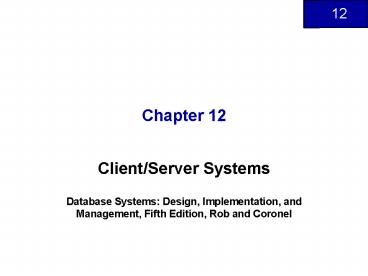ClientServer Systems - PowerPoint PPT Presentation
1 / 26
Title:
ClientServer Systems
Description:
About client/server systems components and how they interact ... Printer and file servers: Novell Netware. LAN protocols: TCP/IP, IPX/SPX, NetBIOS. Middleware ... – PowerPoint PPT presentation
Number of Views:52
Avg rating:3.0/5.0
Title: ClientServer Systems
1
Chapter 12
- Client/Server Systems
- Database Systems Design, Implementation, and
Management, Fifth Edition, Rob and Coronel
2
In this chapter, you will learn
- What client/server computing is
- What the advantages of using client/server
systems are - How client/server systems evolved
- About client/server systems components and how
they interact - What effect the client/server system has on the
DBMS - How client/server systems might be introduced
into an organization - What factors affect the implementation of
client/server systems
3
Client/Server Computing
- Computing model for the development of
computerized systems - Client requests specific service
- Server provides requested service
- Reside on same or different computers
Figure 12.1
4
Client/Server Computing (cont.)
- Key to client server power is where request
processing takes place - Extent of sharing processing
- Thin client
- Thin server
- Fat client
- Fat server
- Classification
- 2-tier
- 3-tier
5
Forces that Drive Client/Server Trend
- Changing business environment
- Growing need for enterprise data access
- Demand for end-user productivity gains based on
efficient use of data - Technological advances
- Growing cost/performance advantages
6
Mainframe vs. Client/Server Systems
Table 12.1
7
Components of Client/Server Architecture
- Client
- Front-end application
- Server
- Back-end application
- Communications middleware
- Communications layer
Figure 12.3
8
Example Client/Server Architecture
Figure 12.4
9
Client/Server Principles
- Hardware independence
- Software independence
- Operating systems
- Network systems
- Applications
- Open access to services
- Process distribution
- Process autonomy
- Maximization of local resources
- Scalability and flexibility
- Interoperability and integration
- Standards
10
Server Components
- File services
- Print services
- Fax services
- Communications services
- Database services
- Transaction services
- Miscellaneous services
11
Server Components
Figure 12.6
12
Server Process Benefits
- Location independence
- Resource optimization
- Scalability
- Interoperability and integration
13
Database Middleware
- Network independence
- Front-end application accesses data without
regard to network protocols - Database server independence
- Generic SQL to access different database servers
- Isolates programmer from SQL dialect differences
14
Communications Middleware
- Two levels
- Physical level
- Client and server computers
- Logical level
- Client and server processes
- Interprocess communication (ICP) protocols
15
Database Middleware Components
Figure 12.9
16
Interactions between Middleware Components
Figure 12.10
17
Middleware Accessing Multiple Database Servers
Figure 12.11
18
Middleware Accessing Mainframe Databases
Figure 12.12
19
Middleware Classifications
- Messaging-oriented middleware (MOM)
- Remote-procedure-call-based (RPC-based) middle
ware - Object-based middleware
20
Competing Standards
- Client operating systems
- Microsoft Windows
- OS/2, Apple Mac OS, Unix, Linux
- Client graphical user interfaces
- Microsoft Windows
- OS/2 Presentation Manager, Macintosh, UNIX
- Server operating systems and network protocols
- Database servers Unix, OS/2, Windows NT
Server/2000 Server - Printer and file servers Novell Netware
- LAN protocols TCP/IP, IPX/SPX, NetBIOS
- Middleware
- ODBC, IDAPI, DRDA, QE
21
Client/Server DBMS Functions
- Transparent data access to multiple,
heterogeneous clients - Allow client requests to the database server over
network - Process client data requests at local server
- Send only SQL results to clients over network
22
Application Logic Components
Figure 12.14
23
Client/Server Architectural Styles
- Two Key Questions
- How is the division made?
- Where should the results of division be placed?
- Five Functional Logic Components
- Presentation logic
- I/O processing logic
- Application of business logic
- Data management logic
- Data manipulation logic
24
Application Functional Components
Figure 12.15
25
Functional Logic Splitting
Figure 12.16
26
Client/Server Implementation Issues
- Management Issues
- Communications infrastructure
- Applications
- Controlling escalating and hidden costs
- People and cultural changes
- Multiple vendor relationships
- Development tool acquisition
- Determination if client/server approach is
correct































